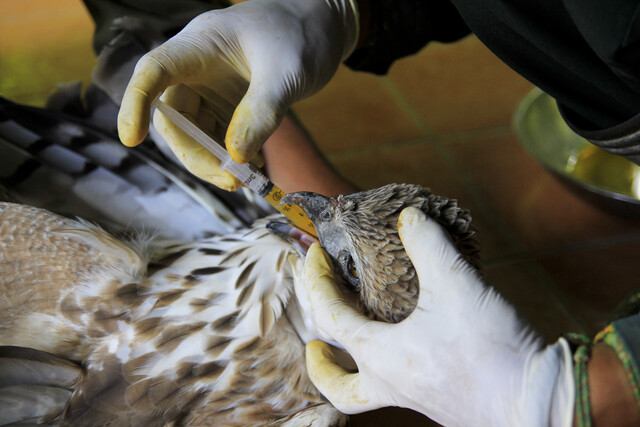It can be intimidating to try and identify the birds you see when you first begin bird watching. The sheer number and variety of birds, along with the slight variations within some species or families of birds, can overwhelm you and discourage you at first. You'll soon realize, however, that you can learn to identify the birds you see by familiarizing yourself with particular traits or features that make differentiating between them easier.
A good field guide will be invaluable, but don't immediately rely on this as you learn more about birds. Instead, consider some of the key markings and try to narrow down the choices based on your own knowledge of other birds. Often you can eliminate a great many suspects simply by considering habitat and behavior, for instance. The factors you need to consider when identifying birds include family traits, behavior, size, color, location and field markings.
Size
When you begin bird watching, one of the things that you'll enjoy the most is the beautiful bird songs and various bird calls you will hear each day. Some birds are more readily identified, in fact, by their distinctive songs or calls than by their appearance. Identifying birds by sound, however, takes a bit longer to learn than identifying them by sight. Each bird species has a particular range and type of songs or calls that it makes, but distinguishing the different ones is a matter of developing an ear for pitch, range, tone and the various notes as well.
If you have an innate musical ability and can readily distinguish between musical notes you have a bit of a head start. Most good bird watching field guides have a brief description of the song or call of each bird so that you have a basic idea of what the bird will sound like. The best way, however, to learn bird calls is to listen to recordings. You can find many CD's that feature a variety of bird songs and calls. The key is to listen to only a few birds at time so that you can really concentrate on learning a few at a time. If you listen to too many of them at once, they will start to become confusing. It's rather like tasting too many wines or sniffing too many scented candles -- after a while, everything starts to blend together and it becomes difficult to distinguish between them all.
As you learn the different songs you may begin to reference them to each other. For instance, you could say that one bird call sounds like a Sparrow's, but the notes are shorter and sharper; or you could say that the new bird you hear sounds much like a Bluebird, but has a deeper tone and uses longer phrasing with fewer repeats.
Roger Tory Peterson, the developer of the first widely used birding field guides in the 1930's, also developed the "field marking" system that is still used today to identify birds based on particular physical features of birds. Peterson realized that the most distinguishing features of birds tended to fall into four specific areas of the bird -- the eye area (eyebrow), the rump (the back of the bird just above the tail feathers), the tail feathers and the wing bars (the distinctive striping or stippling patterns on the wings of the bird.
- Eyebrow (eye area). The pattern of the area around the eye and the eye ring itself is very distinct from bird to bird. You can often determine a particular species amount two or three that closely resemble each other by looking at the ring or stripes or the eyebrow.
- Rump. The rump area of a bird is usually colored distinctly and will often vary from the shadings of the back of the bird and the rest of the feathers.
- Wing bars. These are the stripes or patterns on the wings of a bird. Some will be clear, distinct stripes while others will be stippled or streaked.
-
Tail feathers. The tail feathers of a bird can clearly identify a bird based on the variation in colors at the tip or along the outer edges.
North American Bird Families
Flycatchers
Larks
Swallows & Martins
Bushtits
Chickadees & Titmice
Nuthatches & Creepers
Wrens
Warblers
Wood-warblers
Thrushes
Mockingbirds & Thrashers
Waxwings
Shrikes
Vireos
Grosbeaks & Buntings
New World Sparrows
Tanagers
Cowbirds, Grackles, Blackbirds & Orioles
Finches
Weavers, Starlings & Old World
Sparrows
Other North American Birds
Grebes
Loons
Albatrosses & Petrels
Cormorants
Pelicans
Gannets & Boobies
Herons, Egrets & Bitterns
Storks
Ibises & Spoonbills
Ducks, Geese & Swans
Raptors (Birds of Prey)
Gamebirds
Cranes, Rails & Coots
Plovers
Sandpipers
Seagulls
Terns
Puffins & Murres
Pigeons & Doves
Cuckoos
Owls & Barn Owls
Nightjars
Swifts
Hummingbirds
Kingfishers
Woodpeckers

























